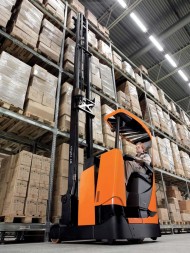 Mark Ogden, product manager, Toyota Material Handling UK explains some of the changes that have delivered a 15% improvement in power consumption for the next generation BT Reflex
Mark Ogden, product manager, Toyota Material Handling UK explains some of the changes that have delivered a 15% improvement in power consumption for the next generation BT Reflex
As part of the development of the next generation of their BT Reflex range, Toyota conducted an extensive user survey to determine the characteristics their customers believed were critical to the success of their businesses.
The results of the survey clearly set the challenge to the Toyota design team – users across Europe wanted a truck that would deliver maximum productivity, but which would also sit comfortably with the green credentials of their operations.
We believe with the new BT Reflex, Toyota has met this challenge. Whilst productivity has increased by up to 12%, intelligent design has also delivered a drop in power consumption of 15%.
Drawing on Toyota’s experience in the automotive industry, the BT Reflex benefits from more advanced electrical components and an improved gear box to reduce the energy consumption of the motor.
The driver can operate the lift and reach functions of the truck simultaneously, improving the number of pallets moved per hour, however the most noticeable improvement can be seen as the forks are raised and lowered, from a technology called Transitional Lift Control.
On a standard truck there can be a noticeable loss of momentum as the fork pass through free-lift. This moment of inertia slows lift and lower speed and saps power from the battery to set the load in motion again.
The software on the BT Reflex has been reconfigured to anticipate the movement of the forks, triggering an increase in hydraulic pressure, ready to cushion the forks through the free lift transition.
This seamless transition as the forks lift and lower, results in reduced cycle times, improved battery performance and smooth, careful handling.
The design of the chassis has also been re-examined to give class leading visibility in all directions, helping operators to manoeuvre with confidence. A low sloping chassis that angles away from the operator, improves visibility of the forks and load, whilst a redesigned overhead guard with matt black angled bars helps to reduce glare, improving visibility of the forks at height.
For high intensity operations or where loads are frequently lifted to height, the BT Reflex Productivity+ option offers a competitively priced package of factory fitted enhancements to help deliver maximum productivity. The Productivity+ package features a tilting cab, unique to the BT Reflex, which automatically tilts from a pre-set lift height, positioning the driver for the best possible view of the forks and considerably reducing neck strain.
The instrument panel follows the cab when tilting, keeping all the controls in the correct position for comfortable operation. Neck bend is reduced by 10°; independent studies show a significant reduction in stress on the driver’s neck and shoulders as this end movement range produces the most strain.
We also expect options like one touch fork levelling and the self-centring side shift to be very popular as not only do they improve safety by reducing the risk of pallets being dislodged from the racking, but also help operators to be more productive.
Toyota Material Handling (UK) Ltd
Tel: 0044 (0)870 850 1400
www.toyota-forklifts.co.uk




Comments are closed.